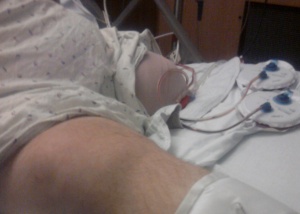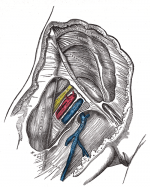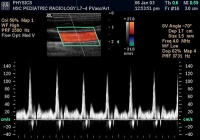Amputations
Lead Editors - Your name will be added here if you are a lead editor on this page. Read more.
Causes of amputations[edit | edit source]
- Diabetes
- Chronic leg ulcer leading to Septicaemia
- Phocomelia (congenital absence of the upper arm or leg)
- Malignant tumours e.g. sarcoma (cancer of the connective tissue)
- Arterial insufficiency leading to death or decay of body tissue (gangrene)
Levels of amputations[edit | edit source]
- Through or just above the ankle
- Below the knee
- Above the knee
- Through the foot
- Through the knee
- The whole leg or disarticulate leg
- Removal of the buttock
Signs and symptoms of gangrene[edit | edit source]
- The tissue is cold and blue (Cyanosis)
- Pain
- Intermittent claudication (a cramping pain, induced by exercise and relieved by rest, caused by an inadequate supply of blood to the affected muscles)
- Clamp-like pain because of a spasm in the arteries of the leg
- Intense ischaemic pain
- Increased prevalence in smokers because nicotine causes spasms of blood vessels
- Most often found in muscles of the leg and calf as a result of atheroma of the arteries
- Leg pulses are often absent
Location of pulses[edit | edit source]
- Foot pulse (Medial malleolus or dorsum of the foot)
- Popliteal (behind the knee)
- Femoral (within the femoral triangle)
- If a leg has been amputated because of gangrene, the remaining leg is examined for a pulse
Special investigations[edit | edit source]
- X-rays
- CT scan
- Angiogram (outlines blood vessels)
- Doppler ultrasound (occlusion of vessels)
- Venogram and arteriogram
- Radioactive dye injected into the blood
Arterial insufficiency[edit | edit source]
- Surgery to improve circulation
- Bypass grafts (autogenous graft uses a vein to bypass the obstructed area)
- Synthetic grafts
Management[edit | edit source]
Buerger’s exercises[edit | edit source]
| [1] |
- Stimulates collateral blood flow in the patient’s leg
- It is performed for 20 min.
- The leg is elevated until the toes go white, then lowered, then level
- Repeat 2-3 times to improve collateral circulation
Connective tissue massage[edit | edit source]
Dynamic stump exercises[edit | edit source]
Balance and gait retraining[edit | edit source]
- Improve static and dynamic balance
- Use Parallel bars, walking frame then Crutches (in that order)
- Therapist stands on the amp side, using a belt around the patient’s waist to support
- Rest if the patient feels tired
Short wave diathermy (SWD)[edit | edit source]
Through the pelvis to warm the arteries (contraindicated in patients with arterial insufficiency because the warmth leads to increased metabolism, causing a greater demand for nutrients, which are not available)
Post-operative care[edit | edit source]
- Maintain function in the remaining leg and stump to maintain peripheral circulation
- Maintain respiratory function (important with smokers and those patients under general anaesthesia)
Stump care[edit | edit source]
| [2] |
- For hygiene and skin care see handout on amputations
- A hip flexion Contracture may develop because of elevation to reduce swelling
- Stump bandaging is done to ‘cone’ the stump, thereby preventing oedema, which occurs because there is no muscle pump and the stump hangs
- Swelling must be prevented to allow proper attachment of the Prosthesis, and the prevention of Pressure sores
- The stump sock is put on first, then the prosthesis
- The prosthesis must be cleaned and maintained (Children who are still growing, grow out of their prostheses)
Types of wheelchairs[edit | edit source]
- For double lower limb amputations, the wheels are set further back
Recent Related Research (from Pubmed)[edit | edit source]
Failed to load RSS feed from http://eutils.ncbi.nlm.nih.gov/entrez/eutils/erss.cgi?rss_guid=14QrMe-OFeMCUTROXREO2Goj4A_9ueFIW_SXkIUqFfh4iIHk-X|charset=UTF-8|short|max=10: Error parsing XML for RSS
References[edit | edit source]
- ↑ ladybessviernes, UDM PT Students. Buerger Allen's Exercise. Available from: http://www.youtube.com/watch?v=jQUFmOmX35o [last accessed 01/12/12]
- ↑ Richard Major. Physiotherapy Stump or Residual Limb Wrapping. Available from: http://www.youtube.com/watch?v=T1SA_6hzTxQ[last accessed 08/12/12]









